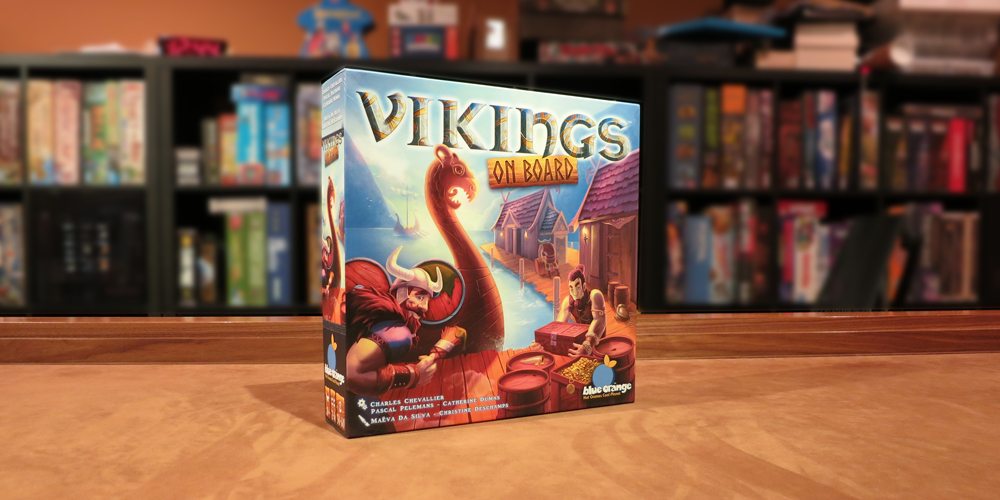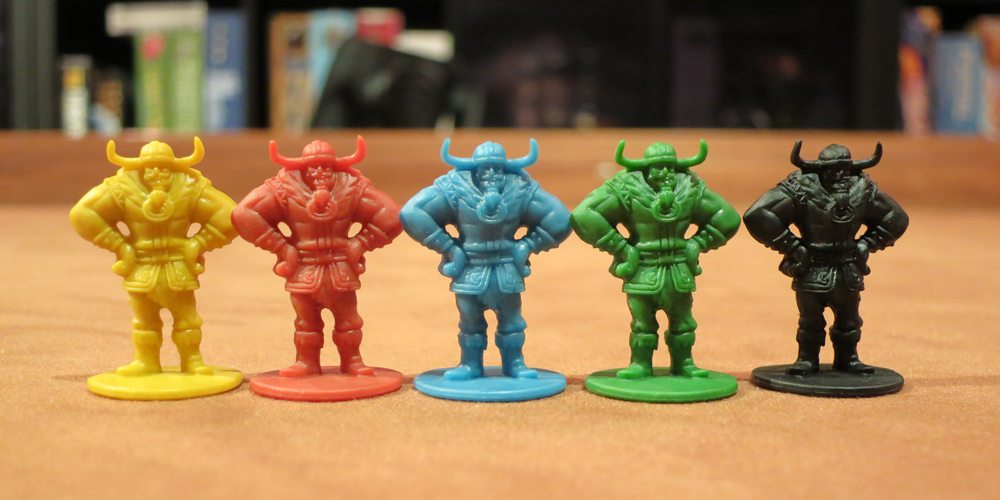
At a Glance
In this worker placement/action selection game for 2-4 players aged 8 and up, you’ll compete with other Vikings in your village to supply and set sail to ships, scoring as many points as possible. Decisions become difficult as options become obsolete and the harbor less inhabited. With Vikings on Board, it’s fun for all in this family-friendly strategy game by Charles Chevallier (Abyss, Kanagawa) for Blue Orange Games.
Components
Inside the box is a small miracle. Yes, there is lots of lovely cardboard, but when you cut back the shrink wrap and open the box for the first time, you will be amazed. The game is ready to play out of the box–there are no sheets of cardboard or building involved. Despite the fact there are a lot of elements involved, everything is already punched out, pre-assembled, and ready to be played. It is as glorious as Valhalla.

Once you get past this initial and wonderful surprise, what’s in the box is also pretty great. There are 17 plastic Viking tokens, four of each color and a black Viking to help keep track of which actions are being chosen that round. There’s a big, colorful board with really nice artwork on it, sharks and tentacled monsters lurking beneath the surface of the fjord, and nice iconography along the Village and Harbor where actions are taken.
There are eight docks along the harbor and each gets a 3D ship bow and a few random ship pieces to start the game. The pieces are all similar in length but carry a variety of shields, representing each player in the game. There are enough sterns for all but one boat. All the pieces are sturdy, strong cardboard with very nice artwork.
There are three types of supplies in the game and each has five tokens for players to stock the ships with. Additionally, there are smaller versions of these tokens for tracking the supply values at the marketplace. Finally, each player gets four betting markers and a large shield token for placing the bets they won and goods they’ve been credited with shipping. It’s all colorful, bright, somewhat comical, and does a great job of capturing the Viking theme.

How to Play
Setup is pretty straightforward. Players pick Viking characters, a scoring token, and four betting tokens, all of the same color. The Vikings are randomly chosen to see who will start the first round then distributed in the Village by a predetermined order in the rule book, depending on the number of players. The black Viking leader is placed opposite them, on the Harbor side, as a reminder of which side players are picking their actions from. The bows are set in the harbor and 3 ship body pieces are randomly placed behind each bow. Supply tokens are shuffled and placed at two locations and market value tokens are placed at the market. You’re now ready to begin.
Before describing the actions a player can take, it’s important to understand the goal of the game and how it is reached. Play takes place over the course of at least seven rounds and the game is over when the seventh ship has sailed from the harbor. One ship will always be left behind since there are only seven sterns.
When a ship sails, players determine who has control of the ship. This is done by counting the number of colored shields each player has on that ship (only count one side). Beginning with the player with the most shields, any supply tokens on the ship are distributed, one per player, in descending order. If there are more supply tokens than players with shields on the ship, they are distributed down the order again, until exhausted. Supply tokens and their values are important; between them and the betting tokens, they are the only way to score points in the game.
Players take turns, working across the board from the side the leader sits on and moves across. Players move from Village to Harbor and Harbor to Village, selecting and taking actions. There are eleven actions in all. Players can:
- First Player – Be the first player for the next round.
- Promote – Move a body piece of your color to the front of a ship (gives you an advantage in ties).
- Jump Your Ship – Move a body piece of your color from one ship to another, placing it at the back.
- Bet – Place one of your gambling tokens in front of a ship, on the color you think will be in control when that ship sails. Bets can only be placed on open spots.
- Add 1 – Draw a supply token, add it to the ship of your choice.
- Marketplace – Increase the value of any single supply by one.
- Jump Any Ship – Move a body piece of any color to the back of another ship.
- Bet/Move a Bet – Either bet (see above) or move an existing bet to an open spot on a different ship.
- Draw 3, Add 1 – Draw the top 3 supply tokens, choose one, and place it on the ship of your choice.
- Set Sail – Place a stern piece at the end of a ship and it will leave the harbor at the end of the round.
- Swap Ships – Exchange any two body pieces between two ships.
These actions are listed in the order that the player will get to choose in the next round. So a player that chooses to Swap Ships will be the last to choose during the next round. There are a few additional rules–ships may never have more than five body pieces and supply tokens may never be moved once they are placed on a ship. When you win a bet or a supply token, it is placed face down on your scoring marker so that your point total remains unknown to other players before the game ends after the seventh ship sails.

Why You Should Play
The rules are pretty straightforward (and short), making Vikings on Board a great family game. However, the gameplay becomes very strategic, making Vikings on Board a challenging family game.
It’s easy to teach and new players can be well into in a game in less than five minutes. Our first game was at the outer range of its expected 30-60 minutes, some of that due to learning the game, some of it was a reticence to sail ships. Subsequent games saw ships sailing much earlier and game times dropping to the lower expected range of time.
One of the minor surprises was how confrontational the game can be. Typically, that’s not the type of game my family likes to play, so I was unsure how it would go. They enjoyed it, but not as much as another group that enjoys a bit more “take that” in their games. When you set sail to a ship, it doesn’t embark until the end of the round, so there’s opportunity for players to affect the number of shields on a ship, completely changing the outcome of who controls the ship—more than once before it sails! You can also send a ship to sea that has plenty of an opponent’s shields on it, but no supplies. It has the potential to become pretty mean, if you let it. But the chaos that can ensue the launching of a ship (especially the final ship) can completely turn the game around, leaving all players wondering who won.
There are definitely more desirable actions than others, however, the really strong actions are found at the end of the action track, meaning you will be going later than other players in the next round. However, if you plan your actions right, you can have multiple turns in a row. And the choices you can make are different enough, it doesn’t feel like multiple versions of the same choice. I don’t see a tremendous difference in the experience, whether playing 2, 3, or 4 players, although four is probably most fun. Depending on the number of players, the game allows for a different number of Vikings you’ll have in play. There are also some minor rule changes for a two and three player game.
As mentioned, it’s a really beautiful game and, with the 3D ship pieces, it’s one that begs you to play with it, which we have been. I’d recommend Vikings on Board, especially for families with kids who are a bit older, since gameplay can become pretty competitive. It’s a good introduction to worker placement and a game that can be set up and played quickly, all of which make it a good game to add to your collection.

Disclosure: GeekDad received a copy of this game for review purposes.




